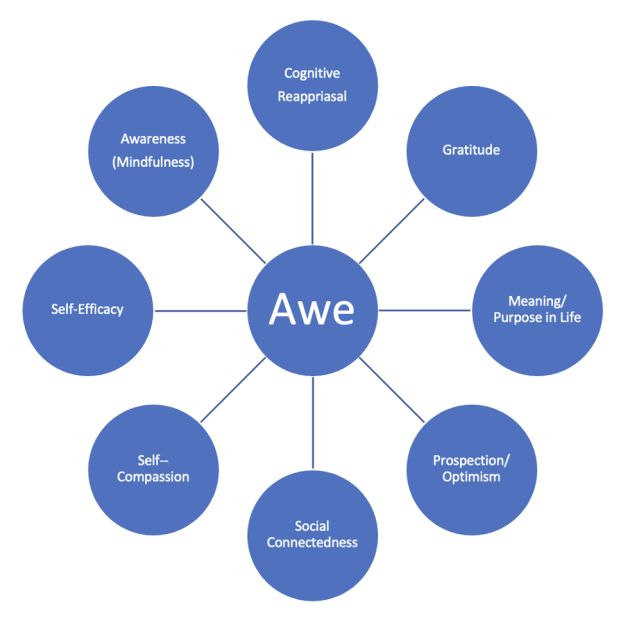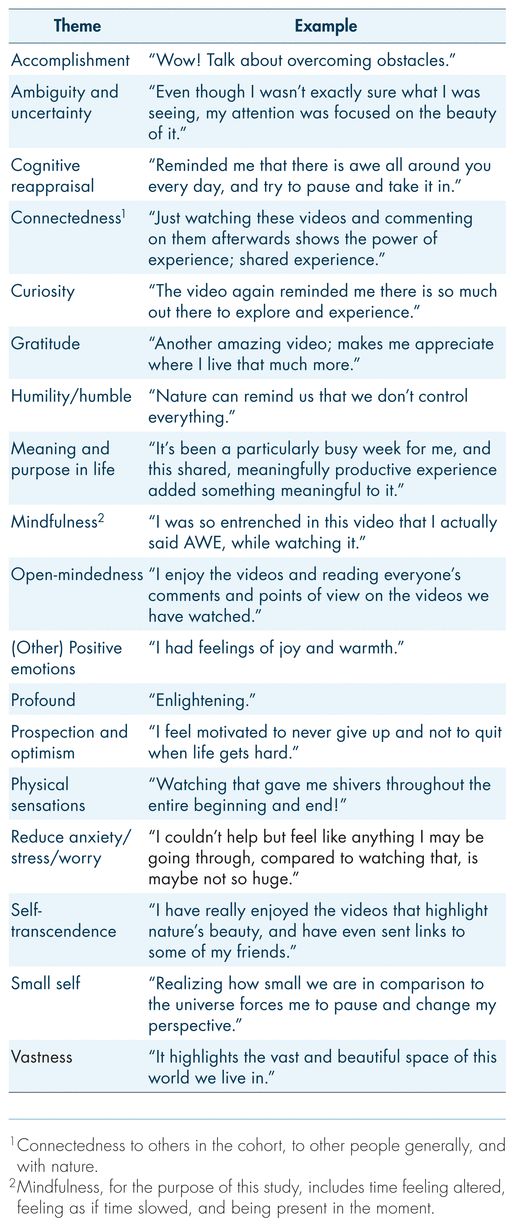Resilience
Narratives and Resilience
You are the author. What story are you telling?
Updated December 21, 2023 Reviewed by Kaja Perina
Key points
- The stories we create and tell shape our identities and reality.
- Reflecting, developing, and sharing awe narratives can be a gateway to other resilience practices.
- We can experience many well-being benefits when we are exposed to the awe/resilience narratives of others.
The stories we construct about our lives don’t tell our identities — they create them. The science of narratives is profound, my recent narrative research published in the Journal of Community Safety and Well-Being (and the research of others) demonstrates that it enhances resilience and supports overall well-being. The narratives we tell ourselves, and others, shape how we recall our past, how we live in the present, and contribute to our future.
Sadie Dingfelder, a writer for the American Psychological Association, got it perfectly when she wrote, “we don’t just tell stories, stories tell us. They shape our thoughts and memories, and even change how we live our lives.”
We are the authors of our life story, so the question is what story are you telling — both to yourself and others? Think of your life story being like a hammer: it can be used to build or destroy, and yet again, you are the one who gets to decide.

Let's examine one element of resilience and narratives: the concept of awe and how it can serve as a gateway to other resilience practices.
Narratives
First, let’s look deeper at the science of narratives. Under the broad term of narrative psychology, studies have shown that both sharing narratives and also being exposed to them can enhance well-being. This includes being able to increase self-awareness, self-efficacy, self-control, openness with others, and better decision-making while also being associated with decreasing anxiety and depression symptoms (for example, see here, here and here).
Awe
Next, let’s examine the concept of awe. Awe has been described as a complex emotion we experience in the presence of someone or something astonishing, and it challenges our current thinking. Awe can be both an ordinary response to something extraordinary like a once-in-a-lifetime trip to somewhere exotic like visiting the Great Barrier Reef. However, awe can also be an extraordinary response to something ordinary.
This means experiencing awe can also occur in everyday moments if we’re open to them, such as thinking of the impact your work has on people’s lives, or seeing something “little” that’s also amazing like looking closely at a flower, a tree, or something else on a daily walk, being captivated by a smile on your child’s face, or marveling at a recent accomplishment of yours or someone else’s.
The video below explains more on awe too (explore many awe research studies here):
From research to practice
When we take the time to reflect on an awe-filled moment in life, either extraordinary or ordinary, we're making time for the good things that are present. Let’s be realistic too, life is full of stressors — they exist and this process isn’t ignoring them. Instead, this narrative practice gives balance in your life by also making time for the good moments which is critical to living a healthy life.
I conduct narrative psychology research, which sometimes is referred to as a narrative health approach, because as Brian Schiff explains, “The umbrella of narrative research gives scholars the intellectual cover to explore questions that are impossible to study statistically.” In my narrative research and programs, I help people develop their life stories through exploring awe narratives and the results truly are amazing. This includes working with NASA leadership, hostage negotiators, leadership, homicide and special victim investigators, and the general public.
So why study awe in relation to narratives and what have been the results? Below are two examples from the list of professionals mentioned above and the table further below gives a snapshot of how reflecting and sharing awe narratives (as well as being exposed to them) can serve as a gateway to many other resilience practices.

A police hostage negotiator on awe:
“It doesn’t take one person to resolve a crisis. And when you are able to take someone’s hand and walk them over to the other side, the good side of the bridge, and you look around you, all the people that were there, and the support that they gave you, most of the time in very, very, bad elements, cold, hot, hungry, and you’re doing your best to save a life, and they hold you up.
They’re there for you.
You know that if something happens, they will step in. When you look around you and you realize that there’s so many good people that are doing a great job, it’s very hard to explain, but it’s like, you know what?
Everything else is just a speck. It’s just dust. You built those bonds with people that are never broken… you were part of something that was greater than you."
A NASA leader on awe:
“[Awe] makes you feel that you are part of something great that’s inspiring — that inspires you to want to learn more, to do more. It makes you feel more passionate about something or just makes you feel wonderful.

Conclusion
Remember, resilience isn’t enhanced by reading, watching or listening to something — it happens through action. Positive thinking is supposed to lead to positive action.
When it comes to action and developing your narrative and life stories, Pamela Rutledge reminds us, “How we tell stories about events, such as what and why something happened and the perceived or expected outcome — forms the basis of resilience.”
So, pick up your “narrative hammer” and try the exercises below to build your awe story.
Exercises
Try doing each of the below exercises at different moments or even in three consecutive days. Also consider doing them with someone else or with a group. Regardless if you do it alone or with a group, don’t just mentally reflect on it, try writing it down too.
Exercise 1: Think of a time you experienced a once-in-a-lifetime moment of awe. What was going on, who else was there, and what other emotions were you experiencing? What is it that made it awesome, and what were some other resilience elements that were also involved (see the circle image above in the article for examples)?
Exercise 2: Think of a time of something that seemingly was normal and ordinary either in your work or your personal life but now that you look at it differently, it is one of those everyday moments of awe.
What other resilience elements are connected to this, and what are some other emotions it evokes?
Exercise 3: What is something in the next few months that you are looking forward to doing that you think will be full of awe? Take a few moments to think more about it including why this, who else will be there, and what other resilience elements will be involved?
References
Rutledge, P. (2016). Everything is Story: Telling Stories and Positive Psychology. In E. M. Gregory & P. Rutledge, Exploring Positive Psychology: The Science of Happiness and Well-Being. ABC-Clio Praeger.
Thompson, J. (2022). Your Daily Dose of Awe: Accessing Real Resilience. PsychologyToday.com. https://www.psychologytoday.com/us/blog/beyond-words/202201/your-daily-dose-awe-accessing-real-resilience
Thompson, J. (2022). Enhancing resilience: An interpretative phenomenological analysis of The Awe Project. Journal of Community Safety and Well-Being, 7(3), 93-110. https://doi.org/10.35502/jcswb.265
Thompson, J., Grubb, A.R., Ebner, N., Chirico, A., & Pizzolante, M. (2022). Increasing crisis hostage negotiator effectiveness: Embracing awe and other resilience practices. Cardozo Journal of Conflict Resolution, 23(3), 615-685. https://static1.squarespace.com/static/60a5863870f56068b0f097cd/t/62c5b…
Thompson, J. (2022). Awe: Helping leaders address modern policing problems. Journal of Community Safety and Well-Being, 7(2), 53-58. https://doi.org/10.35502/jcswb.239
Thompson, J. (2022). Awe narratives: A mindfulness practice to enhance resilience & wellbeing. Frontiers in Psychology/Positive Psychology. https://www.frontiersin.org/articles/10.3389/fpsyg.2022.840944/abstract
Thompson, J. & Jensen, E. (2023). Hostage negotiator resilience: A phenomenological study of awe. Frontiers in Psychology/Clinical Settings, https://www.frontiersin.org/articles/10.3389/fpsyg.2023.1122447/full
Thompson, J. (2023). Narrative Health: Examining the relationship between the phenomenon of awe and resilience and well-being. Journal of Community Safety and Well-Being, 8(2), 85–98. https://doi.org/10.35502/jcswb.321
Thompson, J. (2023). NASA resilience and leadership: Examining the phenomenon of awe. Frontiers in Psychology/Positive Psychology. https://www.frontiersin.org/articles/10.3389/fpsyg.2023.1158437/abstract
Thompson, J. (May, 2023). Experiencing awe: An innovative approach to enhance investigations and wellness. The IACP Police Chief Magazine. https://www.policechiefmagazine.org/experiencing-awe/




